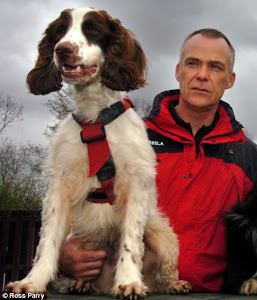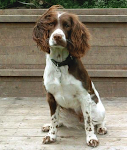Judge's ruling clears way for animals' handlers to testify
October 5, 2012
Chicago Tribune
Clifford Ward, Special to the Tribune
A Kane County judge ruled Thursday that prosecutors in a 1990 murder case could use testimony based on the use of dogs trained to find human remains, perhaps the first time such evidence has been found admissible in a state case.
Judge Timothy Sheldon's ruling could clear the way for dog handlers to provide corroborating evidence in the case of Aurelio Montano, a former Aurora resident and convicted double-murderer who is awaiting trial in the slaying of his wife, Guadalupe Montano.
Prosecutors want to present testimony that the so-called cadaver dogs showed signs that they had detected human remains on a DuPage County farm where prosecutors allege Montano buried his wife after strangling her in July 1990.
Other states have approved testimony over cadaver dogs at trial, and Illinois courts have upheld the use of evidence obtained by drug-sniffing dogs in narcotics prosecutions. But Kane prosecutors said they could find no Illinois state case law supporting the use of dogs that detect human remains.
The judge's ruling came after several hours of testimony from Susan Stejskal, a Michigan resident with a doctorate in toxicology who has trained cadaver dogs and written a book on the subject. Dogs, she testified, rely on their sense of smell, which is substantially better than a person's.
The average human might have 5 million sensory receptors for smell, compared with 300 million for a bloodhound, she said.
"We can't smell the detail the dogs can," Stejskal said.
That ability means dogs can be reliably trained to detect the presence of human decomposition, she said, and conversely, taught to disregard odors of decomposition from other animals.
Prosecutors say cadaver dogs alerted their handlers to the presence of human remains on a Hobson Road horse farm where Montano allegedly buried his wife's body. Montano's brother worked there in 1990 and reportedly told relatives that he helped his brother bury the body, according to court documents.
Convinced that his wife was unfaithful, Montano allegedly strangled Guadalupe, authorities said. He then rolled up her body in a rug, which he placed in his pickup truck and drove to the farm, police allege.
In December 2007, Aurora police conducted a forensic dig at the farm and recovered pieces of a rug. Family members identified it as the rug from the Montano home. Three cadaver dogs sniffed the remnant and gave positive alerts for the presence of human remains, according to court documents.
The farm dig, however, did not produce the victim's body. Other family members reported to police that Montano exhumed his wife's body about four months after she was killed. Her body has never been recovered.
A nephew of Montano's told police that about a year after Guadalupe disappeared, he and Montano were having drinks at Montano's home. Montano, the nephew said, took him into the garage, where he produced a plastic grocery bag that he said contained body parts of his wife, according to authorities.
The nephew, who said he feared Montano, said his uncle placed the bag in the trunk of the nephew's car, and they drove off.
"At some point, the defendant told (the nephew) to stop, get out and dispose of the bag," according to court documents.
Montano was not charged with his wife's murder until 2008. By then, he was serving a life sentence after being convicted of participating in the 1996 drug-related murders of a Texas couple who were hanged in the basement of an Aurora house that Montano was restoring.

 Previous Article
Previous Article





